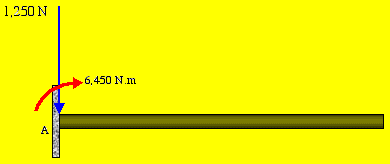Example 3: Replace the parallel force system shown by an equivalent resultant force and couple moment at point A.

Solution: In Example 2 we found the magnitude and location of the resultant force as
| => |
| => |
| => |
| => |

To represent the resultant force by an equivalent force-moment system at point A, we take the intermediate step of adding a set of opposing forces of equal magnitude to the resultant force at point A as shown below.

Recognizing the presence of a couple, we replace the couple by its equivalent moment 1,250(5.16) = 6,450 N.m as shown below.

Since by definition a force couple forms a free vector, the resulting moment vector can be shown at any point. Hence, the equivalent force-moment system at point A is shown below.

In a more general two-dimensional loading case, the forces may not be parallel. Also, the loading may include concentrated or couple moments. The calculation of resultant force and possibly its accompanying moment is demonstrated in the following examples.